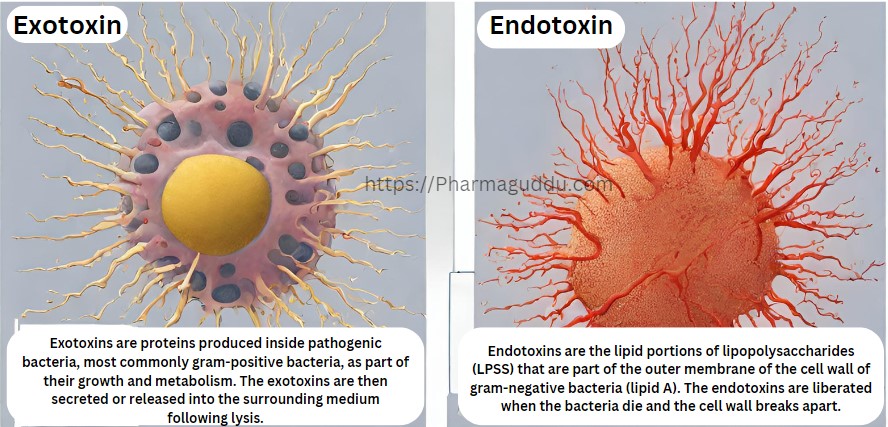Here, Let’s understand the Key Difference Between Endotoxins and Exotoxins. Endotoxins are biological toxins associated with the outer cell wall membrane of gram-negative bacteria such as E.coli, Salmonella, Shigella, Pseudomonas, vibrio cholera, etc. (Endotoxins are invariably associated with gram-negative bacteria whether the organisms are pathogenic or not).
Endotoxins cause big reactions in our bodies, like fever, feeling like you’ve got the flu, coughing, headaches, and struggling to breathe. They’re called Lipopolysaccharides or endotoxins, and they’re made up of fats and sugars. These things stick together in the outer shell of certain kinds of bacteria.
Endotoxins are tricky because they’re a mix of stuff called LPS. LPS itself has two parts: one called Polysaccharide and the other called lipid A. The part that makes you sick is the lipid A, while the other part triggers your body’s defenses.
The outer shell of certain bacteria, called O antigens, is part of these endotoxins. They stir up a bunch of swelling and reactions in our bodies, especially when we’re dealing with infections from these bacteria.
These endotoxins can make most animals sick, but even though they make the body react strongly, they don’t usually protect the body if it faces them again. It’s hard to make them less toxic or harmless. No matter which bacteria they come from, all endotoxins cause pretty much the same effects in our bodies.
When we talk about bacteria, there are these things called exotoxins and endotoxins. Endotoxins are not as strong as exotoxins and they don’t work in a specific way because they don’t use enzymes. You know what’s interesting? Endotoxins can handle heat pretty well, like even if you boil them for half an hour, they stay strong. But there are some strong chemicals like superoxide, peroxide, and hypochlorite that can break them down. Even though endotoxins trigger the immune system a lot, they can’t be turned into less harmful versions.
Related Topic: Differences between injection and infusion
What are endotoxin and exotoxin?
Exotoxins are proteins released by some types of bacteria. They can be easily destroyed by heat and spread into the nearby area. On the other hand, endotoxins are different; they’re made of stable complexes of lipopolysaccharide and protein. They’re part of the cell wall of certain bacteria (the Gram-Negative ones) and only get released when the bacteria die or their cells break open.
Differences Between Exotoxins and Endotoxins

Did you know that lots of bacteria make stuff like toxins, enzymes, and pigments? These toxins and enzymes are pretty important because they help bacteria cause diseases.
There are two types of toxins: exotoxins and endotoxins.
Table Showing Key differences between Exotoxins and Endotoxins:
| Exotoxins | Endotoxins |
| Excreted by organisms, living cell | An integral part of the cell wall |
| Found in both Gram-positive and Gram-negative bacteria | Found mostly in Gram-negative bacteria |
| It is Polypeptide | It is a lipopolysaccharide complex. |
| Relatively unstable, heat-labile (60 °C) | Relatively stable, heat-tolerant |
| Highly antigenic | Weakly immunogenic |
| Toxoids can be made by treating with formalin | Toxoids cannot be made |
| Highly toxic, fatal in ug quantities | Moderately toxic |
| Usually binds to specific receptors | Specific receptors not found |
| Not pyrogenic usually, Toxin Specific | Fever by induction of interleukin 1 (IL-1) production, Shock |
| Located on extrachromosomal genes (e.g. plasmids) | Located on chromosomal genes |
| Filterable | Not so |
| It has mostly enzymatic activity | It has no enzymatic activity |
| Its molecular weight is 10KDa | Its molecular weight is 50-1000KDa |
| On boiling it cannot be denatured. | On boiling it gets denatured. |
| Detected by many tests (neutralization, precipitation, etc.) | Detected by Limulus lysate assay |
| Examples: Toxins produced by Staphylococcus aureus, Bacillus cereus, Streptococcus pyogenes, and Bacillus anthracis (Alpha-toxin, also known as alpha-hemolysin (Hla)) | Examples: Toxins produced by E.coli, Salmonella Typhi, Shigella, and Vibrio cholera (Cholera toxin also known as choleragen) |
| Diseases: Tetanus, diphtheria, botulism | Diseases: Meningococcemia, sepsis by gram-negative rods |

Naresh Bhakar is the Founder and Author at Pharmaguddu.com, bringing his extensive expertise in the field of pharmaceuticals to readers worldwide. He has experience in Pharma manufacturing and has worked with top Pharmaceuticals. He has rich knowledge and provides valuable insights and data through his articles and content on Pharmaguddu.com. For further inquiries or collaborations, please don’t hesitate to reach out via email at [email protected].
